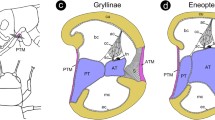Summary
The tympanic organ of the Cicadidae is situated on the abdominal ventral side stretching inside a cuticular capsule, which is formed as an irregular cone-shaped protuberance on both sides of the second abdominal segment. Near the hearing capsule lies the drum in a cavity spanned perpendicularly with regard to the longitudinal axis of the animal. The drum forms a narrow and flat process reaching in the hearing capsule. The tympanic organ is attached to this cuticular body. On the other side the organ is fixed at the integument of the distal part of the hearing capsule. There are two protuberances, to which the scolopidia are fastened.
The tympanic organ consists of about 1300 scolopidia each composed of the following distinct cells: the sense cell, which distally bears the cilium, the proximal attachment cell, the scolopale cell, the cap cell, and a distal attachment cell. Proximal and distal attachment cells mediate the attachment of the organ at the epidermal cells of the cuticle. Numerous folds and much desmosomes associated with microtubules fasten the cells at each other so that the organ is spanned very tightly between the two cuticular bodies.
Zusammenfassung
Das Tympanalorgan der Singzikaden liegt auf der Ventralseite des Abdomens; es ist innerhalb einer cuticularen Kapsel ausgespannt, die als Vorwölbung auf beiden Seiten des zweiten Abdominalsterniten ausgebildet ist. In unmittelbarer Nachbarschaft zur Gehörkapsel liegt das Tympanum; es ist in eine Höhle versenkt, deren caudalen Abschluß es bildet. Das Tympanum faltet sich laterad zu einer schmalen und flachen Duplikatur zusammen, die in die Gehörkapsel hineinreicht und als Ansatzstelle für das Tympanalorgan dient. Die distale Anheftung des Organs erfolgt am Integument der Gehörkapsel. Diese bildet hier zwei Einstülpungen, an denen die Scolopidien in breiter Front ansitzen.
Das Gehörorgan besteht aus ungefähr 1300 Scolopidien; sie bestehen aus folgenden Zellen: einer Sinneszelle, die distal ein Sinnescilium trägt, einer proximalen Anheftungszelle, der Stift- und der Kappenzelle sowie einer distalen Anheftungszelle.
Proximale und distale Anheftungszellen übernehmen die Befestigung des Organs an den Epidermiszellen der Cuticula. Starke Verfalzungen sowie zahlreiche Desmosomen und Mikrotubuli deuten darauf hin, daß diese Verknüpfung sehr fest ist und daß das Organ sehr straff zwischen den Cuticulaspangen ausgespannt ist.
Similar content being viewed by others
Literatur
Bässler, U.: Proprioreceptoren am Subcoxal- und Femur-Tibia-Gelenk der StabheuschreckeCarausius morosus und ihre Rolle bei der Wahrnehmung der Schwerkraftrichtung. Kybernetik2, 168–193 (1965)
Corbière-Tichané, G.: Ultrastructure des organes chordotonaux des pièces céphaliques chez la larve duSpeophyes lucidulus Delar. (Coléoptère Cavernicole de la sous-famille des Bathysciinae). Z. Zellforsch.117, 275–302 (1971)
Eggers, F.: Die stiftführenden Sinnesorgane. Zool. Bausteine2 (1928)
Fawcett, D.: Cilia and flagella. In: The cell. Biochemistry, physiology, morphology, Vol. 2, J. Brachet, A. E. Mirsky, eds., p. 217–297, 1st ed. New York-London: Academic Press 1961
Friedman, M. H.: A light and electron microscopic study of sensory organs and associated structures in the foreleg tibia of the cricket,Gryllus assimilis. J. Morph.138, 263–328 (1972)
Füller, H., Ernst, A.: Die Ultrastruktur der femoralen Chordotonalorgane vonCarausius morosus Br. Zool. Jb. Anat. Bd.91, 574–601 (1973)
Ghiradella, H.: Fine structure of the noctuid moth ear. 1. The transducer area and connections to the tympanic membrane inFeltia subgothica Haworth. J. Morph.134, 21–46 (1971)
Gnatzy, W., Schmidt, K.: Die Feinstruktur der Sinneshaare auf den Cerci vonGryllus bimaculatus Deg. (Saltatoria, Gryllidae) 1. Faden- und Keulenhaare. Z. Zellforsch.122, 190–209 (1971)
Gray, E. G.: The fine structure of the insect ear. Phil Trans, roy. Soc. B243, 75–94 (1960)
Michel, K.: Das Tympanalorgan vonGryllus bimaculatus Degeer (Saltatoria, Gryllidae). Z. Morph. Tiere77, 285–315 (1974)
Schmidt, K.: Der Feinbau der stiftführenden Sinnesorgane im Pedicellus der FlorfliegeChrysopa Leach (Chrysopidae, Planipennia). Z. Zellforsch.99, 357–388 (1969)
Schumacher, R.: Beitrag zur Kenntnis des tibialen Tympanalorgans vonTettigonia viridissima L. (Orthoptera: Tettigonüdae). Mikroskopie29, 8–19 (1973a)
Schumacher, R.: Morphologische Untersuchungen der tibialen Tympanalorgane von neun einheimischen Laubheuschrecken-Arten (Orthoptera, Tettigonioidea). Z. Morph. Tiere75, 267–282 (1973b)
Schwabe, J.: Beiträge zur Morphologie und Histologie der tympanalen Sinnesapparate der Orthopteren. Zoologica50, 1–154 (1906)
Stephens, R. E.: The basal apparatus. Mass isolation from the molluscan ciliated gill epithelium and a preliminary characterization of striated rootlets. J. Cell Biol.64, 408–420 (1975)
Thurm, U.: Untersuchungen zur funktionellen Organisation sensorischer Zellverbände. Verh. dtsch. zool. Ges.64, 79–88 (1970)
Vogel, R.: Über ein tympanales Sinnesorgan, das mutmaßliche Hörorgan der Singzikaden. Z. Anat. Entwickl.-Gesch.67, 190–231 (1923)
Young, D.: The structure and function of a connective chordotonal organ in the cockroach leg. Phil. Trans, roy. Soc. B256, 401–426 (1970)
Young, D.: Fine structure of the sensory cilium of an insect auditory receptor. J. Neurocytol.2, 47–58 (1973)
Young, D.: Chordotonal organs associated with the sound producing apparatus of cicadas (Insecta, Homoptera). Z. Morph. Tiere81, 111–135 (1975)
Young, D., Ball, E.: Structure and development of the auditory system in the prothoracic leg of the cricketTeleogryllus commodus (Walker). 1. Adult structure. Z. Zellforsch.147, 293–312 (1974)
Author information
Authors and Affiliations
Additional information
Mit dankenswerter Unterstützung durch die Deutsche Forschungsgemeinschaft.
Rights and permissions
About this article
Cite this article
Michel, K. The tympanic organ ofCicada orni L. (Cicadina, Homoptera). Zoomorphologie 82, 63–78 (1975). https://doi.org/10.1007/BF00995907
Received:
Issue Date:
DOI: https://doi.org/10.1007/BF00995907




